
Surf is fun and suitable for all levels and ages although it also can be a very difficult, demanding and frustrating sport. We should mix all the components as beach, right material, and conditions to match with the level of each person or group. At Pura Vida surfing school we have a method of teaching that is going to change completely your learning curve. We work on smaller groups by instructor and we will be completely dedicated to each of you on every wave giving you instant feedback about every detail. We also move around different beaches so we can choose the best surf conditions for your skills.
Can I teach myself surfing or should I take surf lessons?
Yes its possible to learn how to surf by yourself. Before all the videos, schools and online coaching people used to learn by practicing, experimenting and seeing the other.
Although it can take way more time and sometimes can be disappointing because there are many things to know at the beginning of your surfing life.
Our Instructors will try to give you the necessary tips about the basics and also to be responsible of what you are doing inside the water. In the surfing world, there are many mandatory rules to follow to avoid problems with other surfers.
Is it too late to start surfing?
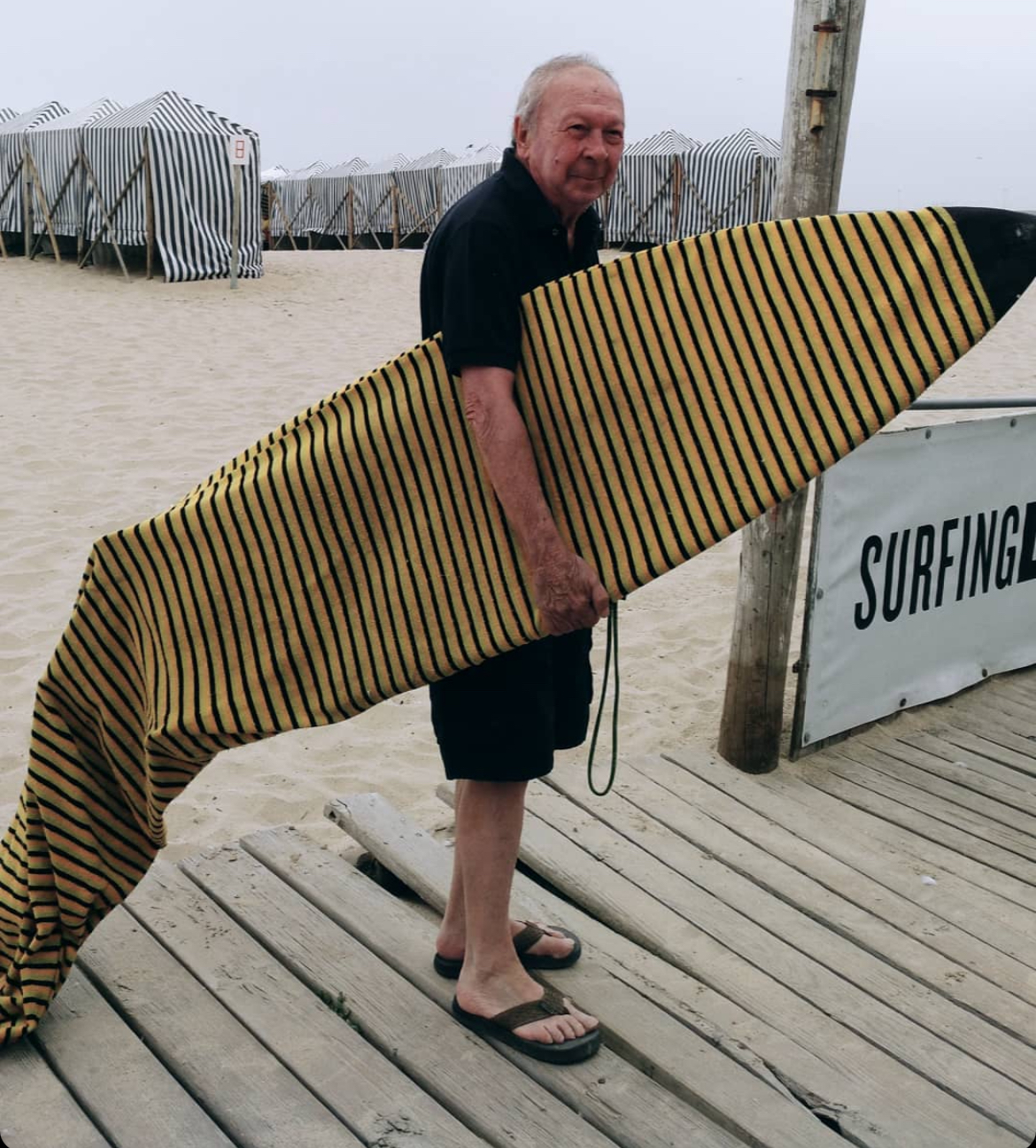
Its never too late to start your surfing journey. Surf is suitable for all ages and people. Surfing is a very inclusive sport. At Pura Vida Surf School we give lessons from 5 to 80 years old.
“The best surfer out there is the one having the most fun” – Duke Kahanamoku
Want to learn to surf quickly? 10 tips for beginners on how to surf
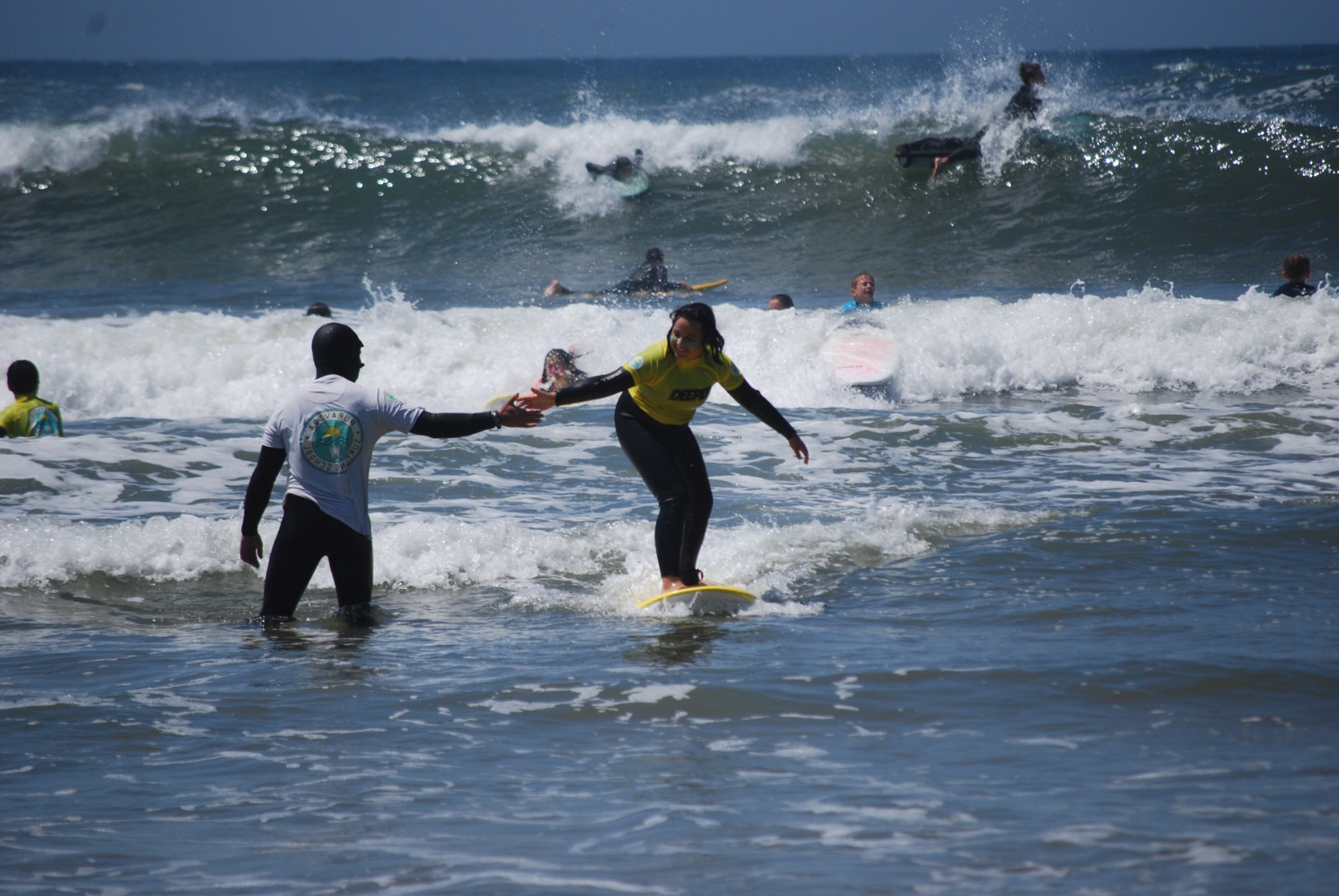
1. Take Beginner Lessons:
Invest in beginner surf lessons. Our Qualified instructors can teach you fundamental techniques, ocean awareness, and safety measures crucial for your surfing journey.
2. Choose the Right Equipment:
As a beginner, start with a longer and wider, more stable board that provides better balance and ease of paddling. A soft-top board is often recommended for its floatability and forgiveness. To choose your board you should consider your height and weight because different people require different shapes and sizes of boards.
Feel comfortable in the water: in Portugal the sea-water temperature is normally cold so you should use thick wetsuits (4/3mm minimum) all year long.
3. Ocean knowledge :
Learn about tides, currents, channels, patterns, sandbanks and waves. Understanding the ocean’s behavior and how it affects surfing conditions is essential for safety and maximizing your time on the sea.
4. Practice Paddling:
Practicing your paddling is a significant part of surfing. Spend time practicing paddling techniques to improve your strength and endurance in the water. Surfers spend 95% of their time paddling and 5% of their time surfing so this is a skill that should be very well developed if you want to use shortboards.
5. Master the Pop-Up:
Work on your pop-up, the transition from lying down to standing on the board requires practice, flexibility and strength. Practice on land to build muscle memory and then try it in the water.
It’s a critical skill for catching waves. At Pura Vida Surfing School, we will teach you the 1 -2-3 method that will make you stand up on your first wave.
6. Choose Appropriate Conditions:
Check the surf forecast. Start with small, calm, manageable waves and calm sea. Starting on the white water will allow you to catch more waves so you can master your base skills.
Choose the right spot for your level. There are beginner spots everywhere in the world.
Trying to surf in overly challenging conditions, as a beginner, can be frustrating and potentially dangerous.
7. Positioning and Timing:
Position yourself properly on the board and time your paddling to catch waves effectively. This skill develops with practice and experience.
8. Respect Local Surf Etiquette:
Understand and follow surf etiquette.
If you are not prepared to paddle out to the outside stay on foam, you will be able to catch way more waves and have more fun.
When you are ready to paddle out respect the lineup, wait your turn, and be aware of other surfers around you. Respect for fellow surfers is the key to be respected too.
9. Stay Persistent and Patient:
Surfing takes time and dedication to improve. Don’t get discouraged by falls or slow progress. Practice and patience are essential in mastering this sport.
10. Stay Safe and Have Fun:
Prioritize safety at all times. Know your limits, respect the power of the ocean, and use proper safety gear like a leash. And most importantly, have fun and enjoy the experience!
Remember, surfing is a skill that develops over time, so be patient with yourself and enjoy the learning process. It’s not just about riding waves; it’s about embracing the connection with nature and the joy of the ocean.
What surfboard is best for beginner surfers?
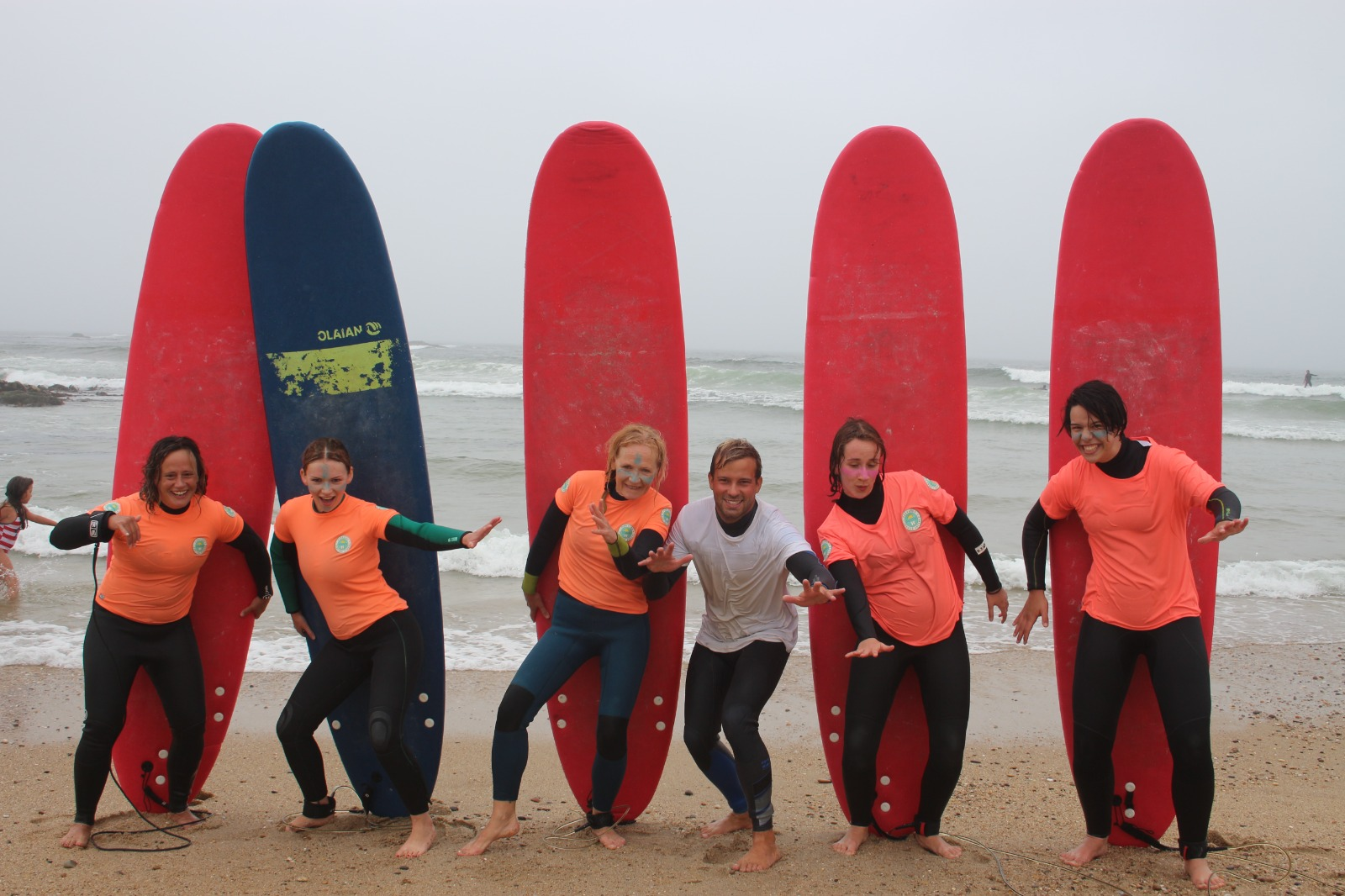
When choosing a surfboard as a beginner, prioritize wide shape, thickness, stability and volume. These factors will make paddling and catching waves more accessible while you’re still developing your skills. As you progress, you can gradually transition to smaller and more maneuverable boards. Always consider your weight, height, and the type of waves you’ll be surfing when making your decision.
Our advice for a beginner surfer would be a board between 8’0 and 9’0, softboard so there’s not so much risk of hurting yourself and also the others, allows you to make mistakes, normally has a lot of volume and is wider than other boards.
A longboard can also be an option, it is easy to get the waves and allows you to make a lot of mistakes.
Always remember: even with a softboard it can also be dangerous when you hit someone, so be respectful and careful when you decide to go by yourself to the water.
Which surf beaches should I visit in Portugal?
Portugal is famous for its fantastic surf destinations along with its extensive coastline. Here are the best surf spots for a surf trip:
Porto (Espinho pointbreaks, Gaia, Matosinhos, Esmoriz):
Why: Multiple spots for all levels and very consistent waves with almost no crowd. The area of Porto is known for their multiple long point breaks with sandy bottom, perfect for learning how to surf or to perform incredible tricks or barrels.
Best for: All levels, from beginners to advanced surfers.
Ericeira:
Why: World Surfing Reserve, multiple surf breaks for all levels, consistent waves.
Best for: Intermediate to advanced surfers.
Peniche Region(Supertubos, Baleal, Almagreira, Lagide):
Why: Situated on a peninsula it’s a place where you always can find offshore winds, it’s a very consistent place and you can find all kinds of surf spots.
Best for: Beginner to advanced surfers.
Nazaré (Praia do norte) :
Why: Home to some of the biggest waves in the world, especially during the winter months.
Best for: Advanced big wave surfers.
Sagres (Tonel and Beliche):
Why: Southwest tip of Portugal, consistent swell, beautiful scenery.
Best for: All levels, depending on the specific break.
Remember that conditions can vary, and it’s always a good idea to check with local surf schools or experienced surfers for the most up-to-date information on the best spots based on your skill level and current ocean conditions. Portugal offers a diverse range of surf experiences, from challenging waves for experts to beginner-friendly beaches, making it an ideal destination for surfers of all levels.
What surfing spots are best for a beginner surfer?
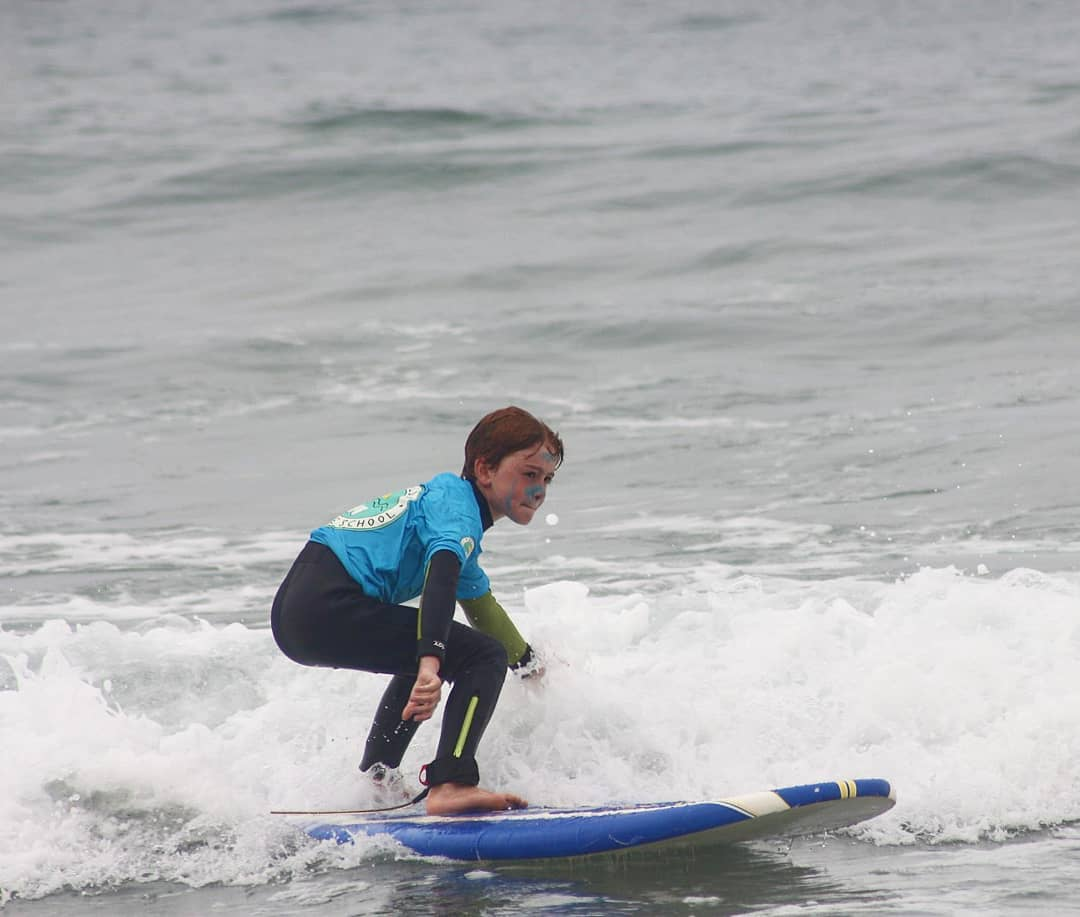
Beginner surfers typically benefit from surf spots with specific characteristics that provide a safe and supportive environment for learning. Here are some key features to look for in surf spots for beginner surfers:
- Sandy Bottoms:
- Why: A sandy bottom is preferable for beginners as it reduces the risk of injuries compared to rocky or reef bottoms. Falls are more forgiving on a sandy surface.
- Consistent, Small Waves:
- Why: Beginner surfers should start with smaller, more manageable breaks. Consistent, gentle waves allow starters to practice paddling, pop-ups, and riding waves without the challenge of fighting against hard situations.
- Slow-breaking waves :
- Why: Curls that break slowly provide more time for beginners to get into position and catch the wave. Fast, powerful breaks can be intimidating and challenging for those just starting.
- Long, Gentle Beach Breaks:
- Why: Beach breaks with long, gently sloping shores allow for a gradual increase in wave size. This makes it easier for beginners to progress as they become more comfortable in the water.
- Shallow Water:
- Why: Beginner surfers often spend a significant amount of time in the shallows, either paddling out or catching whitewater waves. Shallow water ensures a safe learning environment as most of the time the paddling out technique is not developed
- Low Crowds:
- Why: Less crowded surf spots are ideal for beginners. This reduces the risk of collisions, allows more space for practicing, and ensures a less intimidating environment.
- Access to SurfSchools:
- Why: Surf schools often choose beginner-friendly spots for lessons. These locations are selected for their safety, suitable wave conditions, and ease of access for instructors.
- Stable Weather Conditions:
- Why: Stable weather conditions contribute to a more predictable and enjoyable learning experience. You can focus on surfing without worrying about challenging weather elements like strong winds and stormy sea.
- Protected Bays:
- Why: Bays and coves can provide shelter from strong winds and large swells, creating a more controlled and beginner-friendly environment.
- Lifeguard Presence:
- Why: Surf breaks with lifeguards add an extra layer of safety for starters. Lifeguards can provide assistance and ensure a prompt response in case of emergencies.
Popular surf destinations for starters often meet these criteria, but it’s essential to assess each surf spot individually. Additionally, taking lessons from certified surf instructors is highly recommended for proper guidance and safety. Always prioritize safety, respect the locals, and enjoy the learning process at your own pace.
Recommended spots in the area of Porto:
- Espinho – praia do bairro piscatório
- Espinho – praia de Paramos
- Gaia – Canide sul
- Matosinhos
What you must know about surfing safety in the water
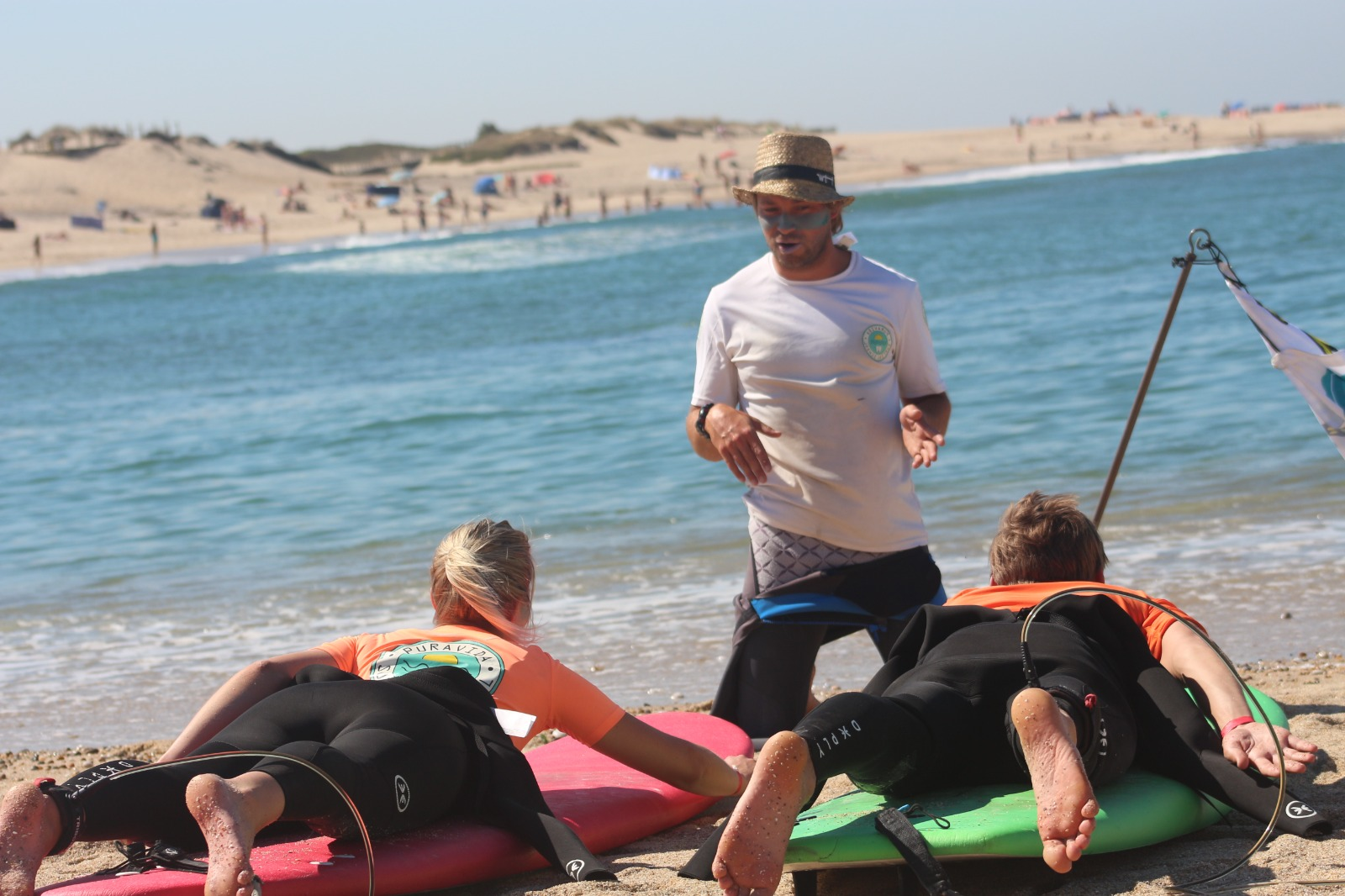
Surfing can be an exhilarating and enjoyable sport, but it’s crucial to prioritize safety to ensure a positive and secure experience in the water. Here are important aspects of surfing safety:
- Learn to Swim:
- Before attempting to surf, it’s recommended to be a strong swimmer. The ability to swim proficiently is a fundamental prerequisite for participating in water sports.
- Take Surf Lessons:
- Consider taking surf lessons from a certified surf instructor to learn how to surf. Proper guidance ensures you learn essential techniques, safety protocols, and ocean awareness.
- Know Your Limits:
- Understand your skill level and don’t push yourself beyond your capabilities. Progress gradually, starting with smaller waves and gradually moving to more challenging conditions as your skills improve.
- Use the Right Equipment:
- Ensure your surfboard is appropriate for your skill level. Starters often benefit from soft-top or foam boards, which are more forgiving in case of falls. Always use a surfboard leash to keep your board nearby.
- Wear a Leash:
- A surfboard leash is a critical safety accessory. It keeps your board attached to your ankle, preventing it from drifting away and posing a threat to other surfers.
- Understand Surf rules:
- Learn and adhere to surf rules. Respect the lineup, take turns, and be aware of other surfers around you. Understanding the rules of the water helps prevent collisions and maintains a positive surf environment.
- Be Aware of Ocean Conditions:
- Before entering the water, assess the ocean conditions. Understand the tide, swell direction, and current. Where the channels are, the wave you are going to surf, the type of wave (mellow or hallow – depending on your surfing skills), which direction of the wave you will surf, if you are a starter on surfing go to a place less crowded. Certified surf instructors can help you with this process.
- Stay Clear of Hazardous Areas:
- Avoid surfing near rocks, piers, or other structures that can pose danger. Be aware of the ocean floor, and stay away from shallow or rocky areas to prevent injuries.
- Know Rip Currents:
- Understand how to identify and handle rip currents. If caught in a rip current, remain calm, don’t fight the current, and swim parallel to the shore until you’re out of the current, then swim back to the shore.
- Check Weather Conditions:
- Be aware of weather conditions, including wind speed and direction. Sudden weather changes can impact surf conditions and safety.
- Use Sun Protection:
- Surfing often involves prolonged exposure to the sun. Wear sunscreen, a rash guard, and a surf hat to protect your skin from harmful UV rays.
- Stay Hydrated:
- Surfing is a physically demanding activity. Ensure you stay hydrated before, during, and after your surf session.
- Surf with a Buddy:
- Whenever possible, surf with a friend. Having someone nearby can be helpful in case of an emergency.
Prioritizing safety enhances your overall surfing experience and ensures a positive relationship with the ocean. Whether you’re a beginner or an experienced surfer, ongoing awareness and caution are key to enjoying the sport while minimizing risks.
Follow the surfing rules and protocols
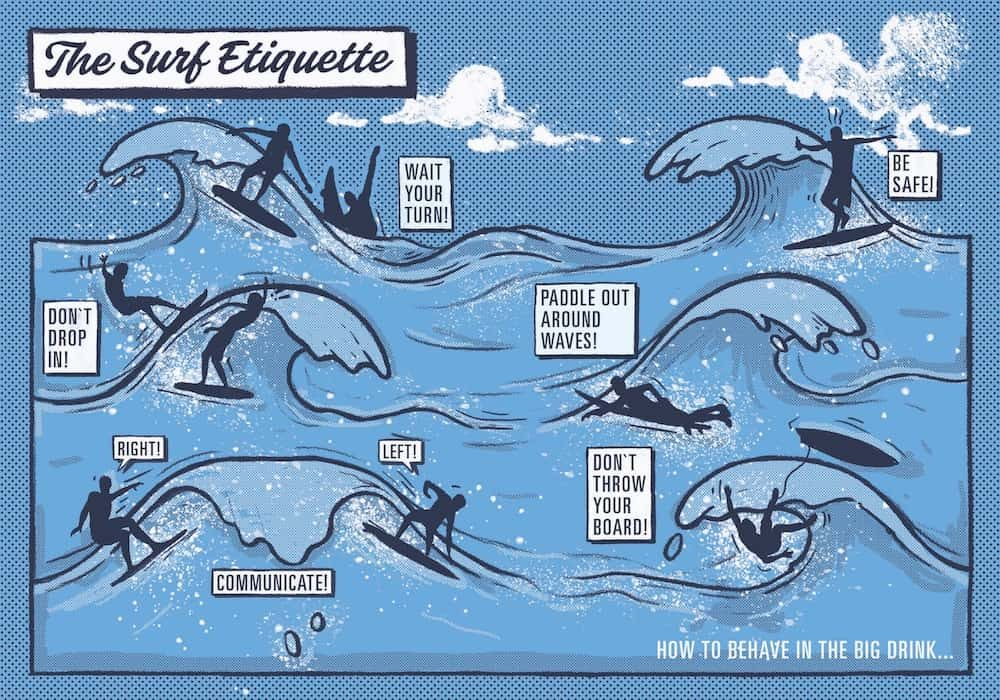
Following surfing rules and protocols is crucial for ensuring a safe and enjoyable experience for everyone in the water. Whether you’re a beginner or an experienced surfer, adhering to these guidelines helps maintain a positive and respectful surfing environment. Here’s a guide on how to follow surfing rules and protocols:
1. Understand Surf laws:
Priorities: The surfer closest to the breaking part of the wave has the right of way. Respect this rule to avoid collisions.
Don’t Drop In: Dropping in, or catching a wave in front of someone who is already riding it, is a major breach of etiquette. Always check for other surfers before paddling into a wave.
2. Respect the Lineup:
Wait Your Turn: Respect the lineup, and wait your turn for the waves. Crowding a lineup can lead to frustration and potential conflicts.
Share the Waves: Be mindful of sharing the waves with others. Communicate with fellow surfers to avoid interference.
3. Communicate Effectively:
Use Signals: verbal communication is essential in the water. Saying what are your intentions or at least using eye contact to communicate your intentions to other surfers will prevent accidents and unwanted situations.
4. Be Mindful of Board Control:
Maintain Control: Always maintain control of your surfboard. A loose board can pose a danger to others. Practice proper duck diving, turtle roll, or simply board handling, and learn to manage your equipment.
5. Respect the Beach and Environment:
Pack In, Pack Out: Bring your trash back to the shore. Keep the beach and water clean.
Respect Nature: Avoid disturbing wildlife, and be aware of local environmental regulations.
6. Follow Local laws and Regulations:
Check Local Laws: Be aware of any specific laws or regulations at the surf spot you are visiting. Some places may have unique guidelines for safety and conservation.
7. Know Your Limits:
Don’t Overestimate Your Skills: Be honest about your surfing abilities. Don’t attempt the waves that are beyond your skill level to avoid accidents.
8. Be Patient and Courteous:
Wait Your Turn: Patience is key in surfing. Wait for your opportunity to catch the waves and avoid aggressive behavior.
9. Give Respect to Earn Respect:
Be Respectful: Treat fellow surfers with respect, whether they are surfing beginner or experienced riders. A positive attitude in the water fosters a better surfing community.
10. Always say sorry for your mistakes
By following these surfing laws and protocols, you contribute to a positive surfing community and help maintain a safe and enjoyable environment for everyone in the water. Always prioritize safety, respect, and communication to ensure a great surfing trip.
Learn to read the wave
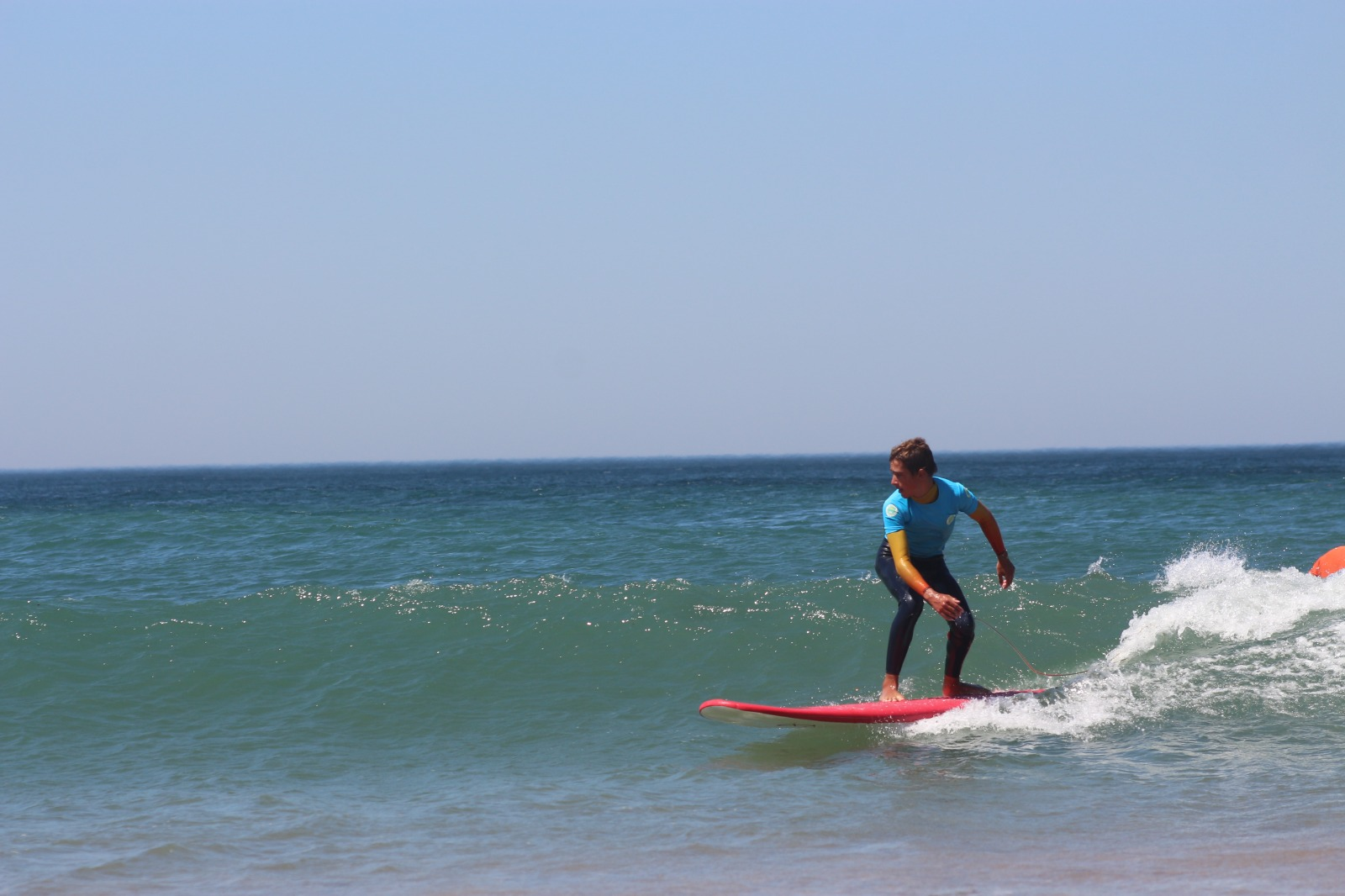
Reading the sea is a crucial skill in surfing, as it helps surfers anticipate and catch it effectively. Here are key elements to consider when reading the waves:
1. Identify the Swell Direction:
Understand the direction from which the swell is coming. This determines how the waves will break.
2. Spot the Peaks and Sets:
Peaks are the highest point of a breaking wave. Sets are groups of waves that arrive in succession. Identify where the peaks are breaking and pay attention to the pattern of sets: check how much time it takes from set to set and where is breaking most constantly.
3. Observe the Wave Shape:
- They break in different ways, and their shapes provide information about their behavior. Some common types include:
- A-Frame: Peaks in the middle, breaking left and right.
- Closeout: Breaks all at once, leaving no open face.
- Reform: Breaks and reforms further down the line.
- Left: breaks to the left and closeouts to the right
- Right: breaks to the right and closeouts to the left
4. Recognize the Wave Size:
Understand the size of the waves by observing the height of the breaking part (face) of the wave. Choose the place where you are going to surf considering the size that fits better for your level.
5. Take Note of Wind Conditions:
Wind can greatly affect wave quality. Offshore winds (blowing from the land to the ocean) generally make for cleaner waves, while onshore winds (blowing from the ocean to the land) or side shore can create choppy, messy conditions.
6. Look for Channels and Sandbars:
Channels are deeper areas between sandbars or reefs, and they often indicate where waves will break less consistently. Sandbars can influence how waves break, creating specific peaks and sections.
7. Be aware with Wave Behavior on Different Tides:
With the different tides, the surfing will also change depending on the reef or sandy bottom, so you should have an insightful attitude adapting your position and your type of surfing.
8. Position Yourself Properly:
Anticipate where the best waves will break and position yourself accordingly. Avoid getting caught inside by paddling out at the right time.
9. Watch Other Surfers:
Learn from more experienced surfers. Observe their positioning, the waves they choose, and how they navigate the lineup.
10. Be Patient and Attentive:
Spend time observing the waves before paddling out. Patience and attentiveness help you understand the wave dynamics and make better decisions.
12. Practice and Learn Over Time:
Reading the sea is a skill that improves with practice. Spend time in the water, experiment with different positions, and learn from each surfing session.
Reading the ocean is a combination of knowledge, observation, and experience. It’s a skill that develops over time as you become more familiar with the characteristics of different surf breaks.
Top Beginner Surfer Mistakes
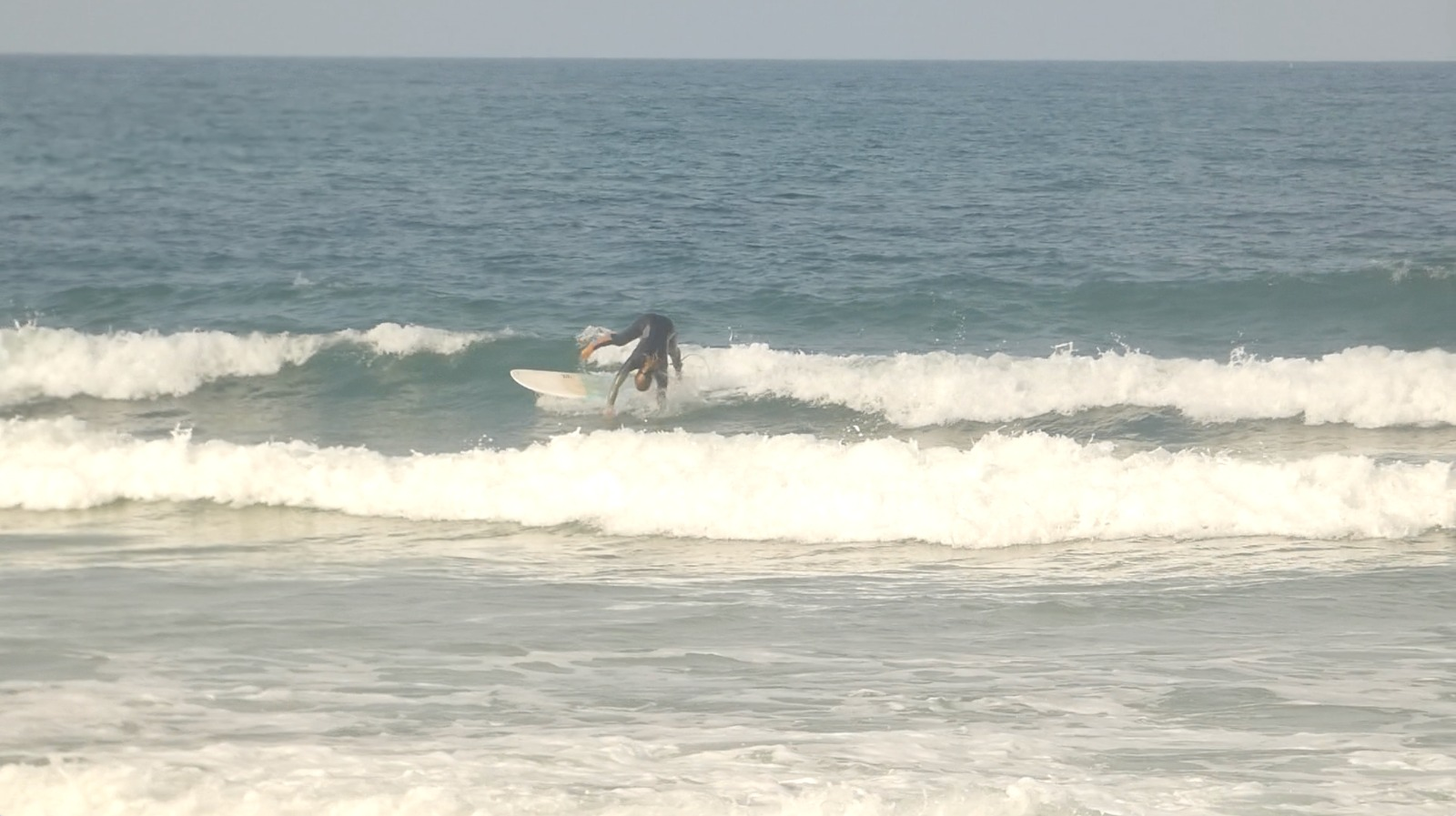
Learning to surf is an exhilarating adventure, but beginners often encounter common mistakes that can hinder their evolution. Recognizing and addressing these issues is crucial for a smoother learning experience. Here’s a concise summary of the key points:
Beginner Surfing Mistakes and Solutions:
- Board Selection:Mistake: Using a board that is too small.Solution: Start with a larger surfboard, with a round nose and wide for bigger stability, then transition to a smaller board size as skills improve.
- Paddle Technique:Mistake: Using inefficient paddle strokes.Solution: Focus on deep, engaged strokes from the front of your nose until the end of the stroke, using core muscles.
- Body Position:Mistake: Poor body positioning on the board.Solution: Lie with your chest at the board’s center for stability, close your legs, and look forward to where you want to go.
- Wrong stand-up techniqueMistake: Not using the proper techniqueSolution: Learning the wrong technique of standing up will develop bad habits and more common mistakes, make sure you take surf classes to learn how to stand up properly and get your feet in the right position.
- Lack of Awareness and knowledge about safety procedures:Mistake: Not checking for other surfers or hazards, don’t know safety aspects in the water.Solution: Constantly scan your surroundings and be aware of the water, don’t leave your board alone when you see a wave, don’t get hit by the board when you put it in front of you, always by your side, and always protect yourself so you don’t get hit by the board when you fall.
- Impatience:Mistake: Trying to catch every wave.Solution: Be patient and selectively choose the right wave based on skill level.
- Commitment and making decisions:Mistake: Hesitating when paddling and standing up for a waveSolution: Confidence and Commitment are two of the most important abilities in surfing, when you want to catch a wave you should put all your effort and show “interest” in what you are doing the earlier you can so that others also can understand what you are doing.
- Surfing etiquette:Mistake: Disregarding the surfing etiquette.Solution: Learn and follow etiquette to maintain a positive surf environment.
- Fear of Falling:Mistake: Being overly afraid of falling.Solution: Embrace falls as part of the learning process and focus on improving balance.
- Ocean Awareness:Mistake: Neglecting understanding of tides, currents and types of curls.Solution: Educate yourself about local conditions for a safer surfing experience, you will not want to go to a beach where your ability level doesn’t match.
- Physical Fitness:Mistake: Neglecting overall fitness.Solution: Stay physically active and incorporate exercises that enhance strength, flexibility and endurance. Surfing is 95% of paddling and 5% of riding the waves.
- Persistence:Mistake: Giving up too soon. Surfing is a very frustrating sport as the learning curve is very slow depending on how much you practice.Solution: Be patient, persistent, and enjoy the learning process.
- Taking Lessons:Mistake: Trying to learn without proper instruction.Solution: Invest in a certified surf guide they will give you the right feedback and surfing tips, this will make your ability level get better and with fewer bad habits.
Addressing these mistakes ensures a positive learning experience, allowing beginners to progress effectively and enjoy the journey to becoming proficient surfers.
What surf gear should I bring to my first surf lessons?
Nowadays surfing schools and surf camps are prepared with most of the gear. They offer you a full surf experience including everything: surfboards, wetsuits adapted to the water temperatures, leash, wax, and, if you request transfer to the beach.
So basically for your first surf lesson, you should bring a towel, swimwear, sun protection, and most importantly: motivation to learn how to surf.
Ways to increase paddle power
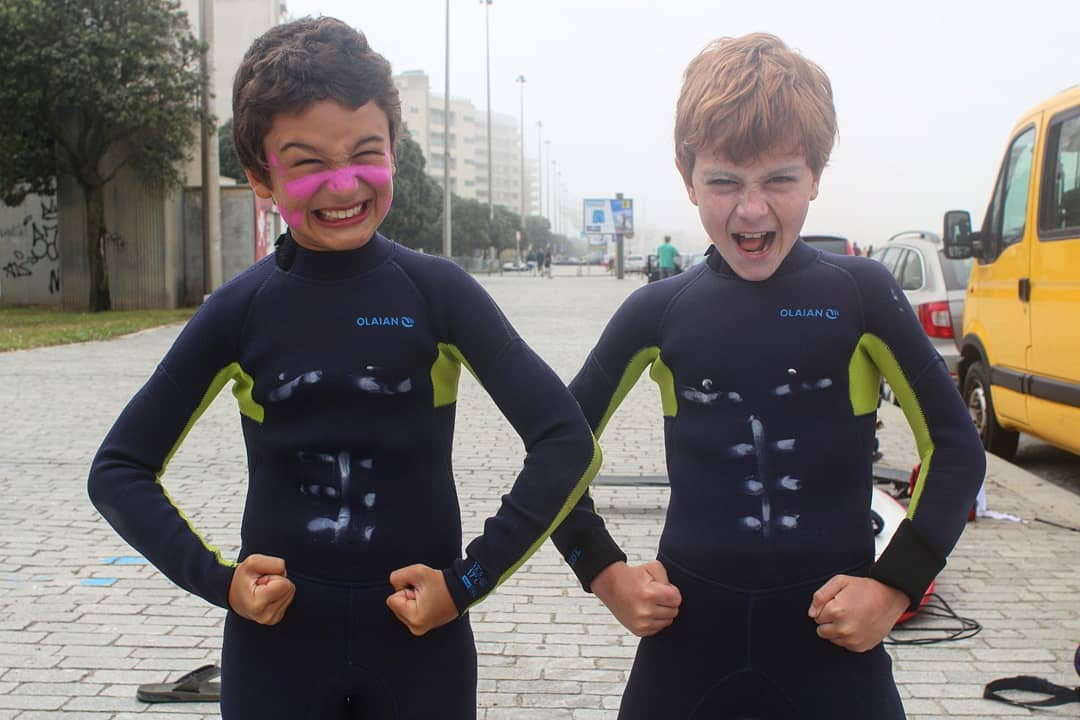
Increasing paddle strength is essential for surfers as it allows for better maneuvering, catching the waves more efficiently, and covering greater distances. Here are ways to enhance your paddle endurance and strength in surfing:
1. Improve Technique:
Long, Deep Strokes: Reach forward as far as possible with each stroke, and use a long, deep paddle motion to maximize your propulsion.
2. Develop Core Strength:
Core Exercises: Strengthening your core muscles, including your abdominal and lower back muscles, will improve your stability and power in paddling.
3. Enhance Shoulder Strength:
Shoulder Exercises: Strong shoulders are crucial for paddling power. Incorporate exercises like shoulder presses, lateral raises, and rotator cuff exercises into your fitness routine.
4. Perfect Body Position:
Streamlined Position: Maintain a streamlined position while paddling. Keep your body flat on the board, and avoid dragging your legs in the water.
5. Increase Endurance:
Cardiovascular Training: Enhance your overall endurance through activities like swimming, running, or cycling. Improved cardiovascular fitness helps sustain paddle power throughout the surf session.
6. Optimize Equipment:
Choose the Right Board: A board with proper floating and stability will make paddling easier. A board with a good glide helps conserve energy during each stroke.
Join us for the best surfing in town
Book your experience with us here –> Pura vida surfing school Surf classes
